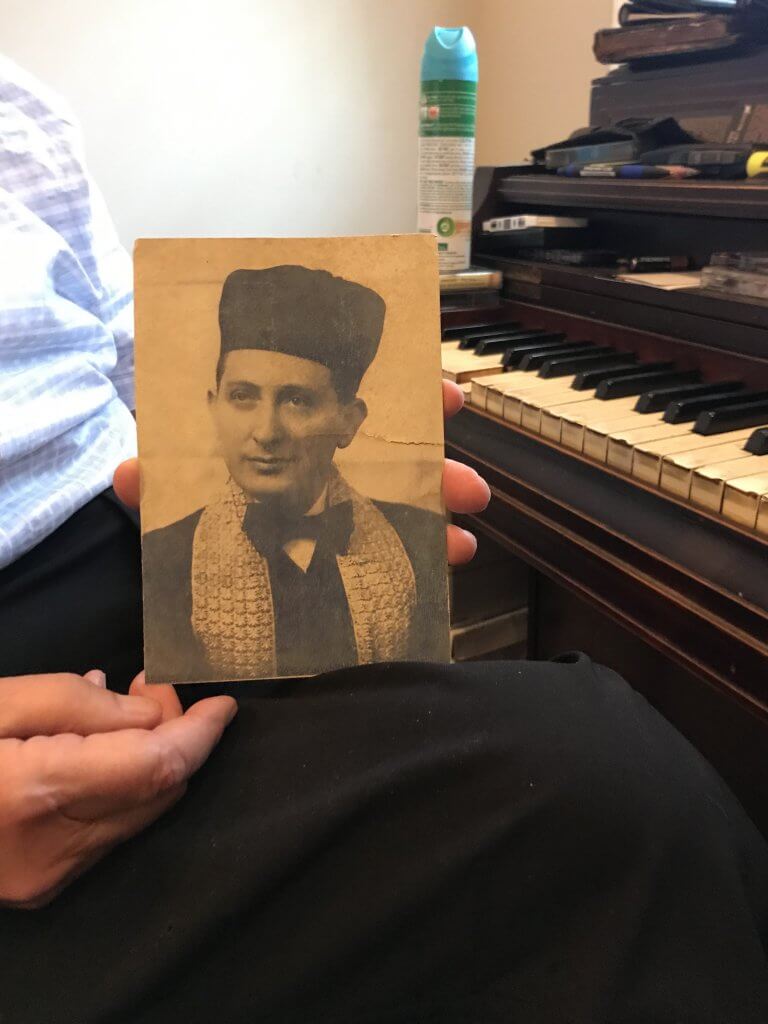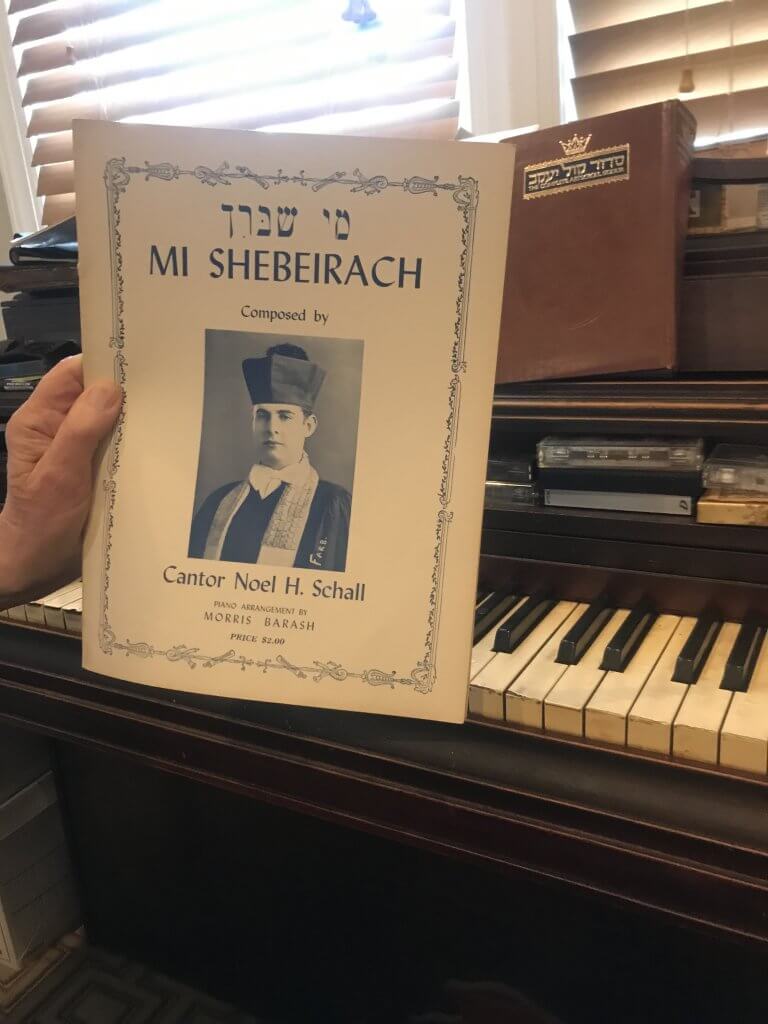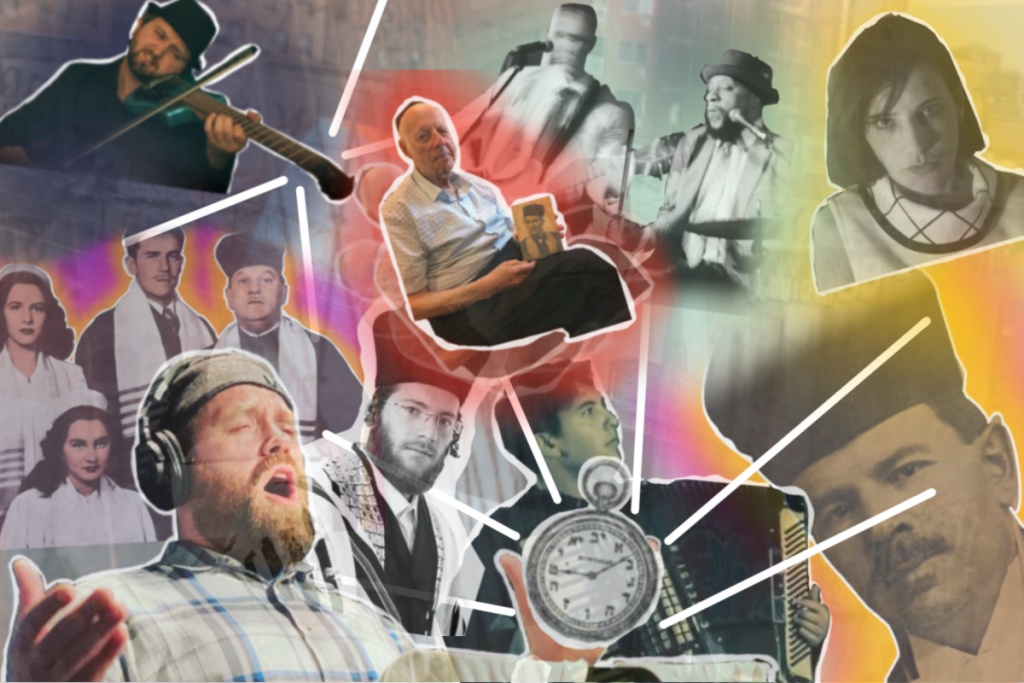by Jeremiah Lockwood, Research Fellow
Lowell Milken Center for Music of American Jewish Experience
A conversation with elder cantorial pedagogue Noah Schall unfurls a parade of images and ideas about Jewish liturgical music, stemming from a lifetime immersed in the music.
I last visited Noah Schall at his home in the Five Towns area of Long Island on July 30, 2021. Schall is now 92 years old. It had been a few years since I had seen him, before the pandemic. Schall is visibly older and seems perhaps somewhat more tired than in previous visits, but that reduction is from a very high bar. His memory is deep, his thoughts ready and sharp and his musical judgements decisive and clearly defined at all times.
Before reporting some details from my “deep hang” with Schall, I will offer a few words about his lengthy career in Jewish music for the benefit of those who are unfamiliar with his life and work. Schall was born in Williamsburg, Brooklyn in 1929, the son of a singer who worked with the legendary cantorial composer and choir leader Seidel Rovner (1856-1943). Schall took his first music lessons with Rovner’s son, Elias, also a cantor and composer, who taught him to read music. Schall claims to have been self-taught as a cantor; he was active in a neighborhood-and community-based Orthodox Jewish music scene. Schall began training cantors when he himself was still a teenager. Later, he has served as an instructor in the cantorial training programs of the Reform, Conservative and Orthodox seminaries. Schall has produced cantorial records, and published anthologies of nusakh hatefillah (Hebrew, the manner of prayer; used in cantorial discourse to describe prayer modes and melodies) and transcriptions of classic recorded cantorial recitatives, work he continues up until the present. He also developed a close working relationship as a musical consultant to Moshe Genchoff (1904-1997), one of the last “star” Eastern European-born cantors working in the United States. Schall’s personal association with “golden age” cantors and his unique talents as a creative artist in the genre makes his approach to teaching nusakh especially attractive to singers who favor the sound of classic cantorial records, including aspiring cantors from the Chassidic community. Schall is an important figure in my doctoral thesis research and forthcoming book project, Golden Ages: Chassidic singers and cantorial revival in the digital era.

I arrived at Schall’s house and after being greeted by his new full-time nurse, we retired to his study, a back room with a piano and piles of cantorial scores, some over a hundred years old. I told Schall about my job working as the lead researcher for the newly established Cantorial and Synagogue Music Archive, collecting and digitizing old cantorial scores. I asked him if he had known Shimon Raisen (dates of birth and death unknown), an early 20th century cantorial pedagogue whose musical manuscripts I have been cataloguing. He did indeed know Raisen and offered some comments differentiating between the depth of the kind of service he offered as a teacher to aspiring cantors, in contrast to other cantorial pedagogue figures, such as Jacob Rappaport (1890-1943). Rappaport, a president of the khazones farbund (Yiddish, the cantorial union), wrote many compositions which he sold to cantors in the form of sheet music, on the condition that they agreed not to share the music with other cantors. For Rappaport, the compositions were his proprietary material and comprised the sole substance of what he had to offer novice cantors who were seeking to enlarge their repertoires. In contrast, Raisen would meet with each student cantor individually and would adapt compositions to their individual voices, helping cantors develop a repertoire and a sense of individual style. Schall said that Raisen could take a five note phrase a novice cantor would bring to him and help the singer develop this solitary idea into a full-fledged cantorial composition.
We talked about cantorial scores and how interpreting them takes special knowledge, a subject I have discussed with Schall in the past and that is the subject of an article I wrote. To illustrate the approximate nature of the relationship of notation to cantorial performance, Schall took the example of a descending minor triad and sang a three-note passage in the styles of Berele Chagy (1892-1954), Moshe Koussevitzky (1899-1965) and Samuel Vigoda (1895-1990). Even with his old and frail voice, his impersonations of the great cantors perfectly captured their styles and vocal mannerisms.
I reminded Schall that I was the grandson of Jacob Konigsberg (1921-2007), one of his first students. Schall was pleased by the memory and took out a photograph of my grandfather that he happened to have lying in a pile on his piano, taken in the 1940s.

Then Schall showed me his first published composition, Mi Shebeirach, that he had self-published in 1950. There was a staged photo of him on the cover of the sheet music. In the picture he wore my grandfather’s cantorial robe that hangs in a closet in my mother’s apartment. Schall didn’t yet own a cantorial robe and borrowed my grandfather’s for his photo session. Schall said, perhaps jokingly, that he had published the piece on a dare. He brought copies of his self-published piece to Metro Music, on 2nd Avenue in Manhattan, the premiere seller of Jewish music, seeking to sell the sheet music on consignment. Henry Lefkowitz, the owner, wouldn’t believe that Schall had written it because he looked so young. He assumed the music written was plagiarized. Later, a third party intervened and vouched for Schall’s honesty, and the store did take some copies to sell. Schall said all other copies were destroyed in a basement flood, and this was perhaps the only one left in the world.

I asked Schall to tell me what Jacob Konigsberg, my grandfather, was like as a student. Schall said that he was nervous and sometimes yelled at him, the teacher, if he criticized his singing. Konigsberg started to come to Schall after he had been studying with cantorial pedagogue Louis Lipitz (1887-1958). Schall was mildly critical of Lipitz, suggesting he might have copied some of his pieces from other sources. [1] Schall would compose pieces for my grandfather or adapt already existing pieces to suit his beautiful upper range notes. He recalled helping Konigsberg prepare for his broadcasts on WEVD, the Yiddish language radio station founded in 1927 by the publishers of the Jewish Daily Forward (Forverts) newspaper.
As is often the case in discussion with Schall, our talk meandered to the subject of music theory and cantorial music, with Schall offering keen insights in a charmingly insouciant and conversational style. Schall highlighted the importance of the subtonic in Jewish music, offering the elliptical comment “F and G are relative by us.” By “us” I understood him to mean Ashkenazi Jews of Eastern European heritage. In this statement, G is assumed to be the tonic and F the subtonic. In Schall’s discussion of the melodic system of Jewish prayer music, sometimes referred to as nusakh hatefillah (Hebrew, the manner of prayer), he appropriates the Western theoretical construct of relative keys, that usually describe the relationship of major to minor, in a metaphorical manner to name the relationship of different modal areas that are frequently put together. For example, the typical melodies sung by Ashkenazi cantors for Nilo (the concluding service for Yom Kipur) or for the Shakhris (morning service) of the “three festivals” (Passover, Shavuos and Sukkos), feature a characteristic descending movement from “stable” notes of the tonic triad, down by a step.
Schall interprets these melodic movements as building blocks of a distinctive Jewish music theoretical structure in which the relationship between modal phrases built on the tonic and subtonic plays a pivotal role. This kind of modal relationship can be found in countless compositions by cantors, as well as in Yiddish folk songs and Chassidic nigunim (Hebrew, wordless devotional melodies). The Jewish “relative modes” are employed to construct musical ideas that often bear meaning, expressing abstract feelings or ideas related to prayer texts or ritual contexts through sound. [2]
In a related tangent, Schall discussed the different varieties or styles of nusakh (an abbreviated version of the term nusakh hatefillah, referred to above) in Ashkenazi liturgical music. For reasons that are not clear, the different forms of nusakh are most widely variant from one another in the mariv service for the Sabbath, sung every week on Friday night. According to Schall, the four forms of the mariv nusakh are:
1. Chassidic minor
2. Chassidic major
3. Lithuanian
4. Koralishe (Yiddish, choral)
The two “Chassidic” variants are heard commonly today in Brooklyn and other areas with Chassidic populations. The “Lithuanian” nusakh is the predominant style heard in American synagogues in the liberal movements, which tend to be strongly influenced by the cantorial anthologies of Gershon Ephros (1890-1978) and Adolf Katchko (1888-1958). These mid-20th century anthologies are used as pedagogical materials in the cantorial training programs of the Conservative and Reform seminaries. Both Ephros and Katchko were Polish Jews; the reasoning that led to their adoption of what is commonly understood to have been a “northern” Jewish style for the Friday night prayers is unclear. The aesthetic decisions in their anthologies have led to the reification of one strand of Jewish synagogue sound as the presumed norm in much of the American Jewish community. [3] The koralishe nusakh, according to Schall, is the version associated with the “choral” synagogues of Eastern Europe, elite places of worship for Jews of the upper classes that employed professional cantors and choirs. [4] The koralishe style is the least frequently heard form of nusakh today, although some pieces written by synagogue composers for use in 19th choral synagogues have become standards that are still in use by congregations. Schall sang for me the beginning of the koralishe nusakh for mariv. It sounded very similar to the “Lithuanian” style but used a major third instead of the familiar minor modality, to create a “grand” effect.
Schall told me some anecdotes about the beginning of his cantorial career. By the age of 16, Schall was confident enough in his musical skills to begin working as a cantorial pedagogue, teaching cantors who could not read music, training them by ear to memorize pieces they had acquired sheet music for. In the early years of his career, Schall’s pedagogy consisted of helping fledgling cantors make sense of musical scores, translating the written notes into musical practices that were consistent with conventions of cantorial vocal performance. It was understood that even for singers who could read the notes, a “straight” reading of the score would produce an inadequate performance and would not sound “cantorial.” The score needed to be supplemented by knowledge of phrasing, ornamentation and culturally specific forms of vocal timbre.
Schall was not getting paid at this early point in his career. Instead, he would barter his services for sheet music, copying out for himself pieces that cantors had paid Rappaport and other composers handsomely for. In those days, cantorial scores were jealously guarded tools of the trade. Hence Rapaport’s demand for secrecy around his compositions. Clearly the promises of discretion by his customers were not always kept and “secret” pieces entered popular circulation in the cantorial community through hand copied pirated versions.
These anecdotes point to the great value and prestige that once resided in cantorial manuscripts, adding extra pathos to the fact that old cantorial scores today are a burden of bulky ephemera, taking up space in cramped living spaces, waiting to be thrown out by families when elder cantors pass away. Gesturing to his boxes and shelves overflowing with century-old manuscripts, Schall said, humorously, sadly, bitterly, “What does anybody want with it? No one knows what to do with it. It will all go in the garbage.”
The line between archive and eccentric hoarding, between treasure and garbage, is painfully thin. As Derrida wrote, legitimacy is granted to an archive by power-wielding authorities associated with structures of the state. [5] In the absence of a legitimizing structure of authority, and a paucity of use value due to the present reduced interest in cantorial art music, the value of his collection is ambiguous. I voiced my own personal excitement and faith in the value of the history and aesthetic power his collection and his knowledge represent. I made my claims that there are possibilities in the future we cannot see, and that the archive can bloom with new life. Schall was skeptical but amused.
I will visit Schall again soon and offer more details from his teachings as the year progresses. Stay tuned to Dispatches from Brooklyn…
NOTES
1. Plagiarism and accusations of plagiarism were plentiful in the early 20th century cantorial scene, in part because having a uniquely effective piece for auditions at synagogues was an important step towards employment. For an account of a cantorial audition where multiple cantors were pitted against each other, see Vivi Lachs, ed. London Yiddishtown: East End Jewish Life in Yiddish Sketch and Story, 1930–1950: Selected Works of Katie Brown, A. M. Kaizer, and I. A. Lisky (Detroit: Wayne State University Press, 2021), 88-91.
2. Joel Rubin has developed a related concept of relative modal areas in Ashkenazi Jewish music in a different context in his analysis of klezmer music. See Joel Rubin, New York Klezmer in the Early Twentieth Century: The Music of Naftule Brandwein and Dave Tarras (Rochester, NY: University of Rochester Press, 2020), 122-174.
3. See Boaz Tarsi, “Observations on Practices of Nusach in America.” Asian Music 33, no. 2 (2002): 175–219.
4. See Vladimir Levin, “Reform or Consensus? Choral Synagogues in the Russian Empire,” Arts 9, no. 72 (2020):
5. See Jacques Derrida and Eric Prenowitz, Archive fever: a Freudian impression (Chicago: University of Chicago Press, 1996).


